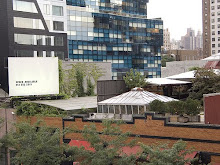
 1) Archival photo of youths outside Stonewall Inn, featured on the cover of the Village Voice, July 3, 1969, © Fred W. McDarrah. 2) Outside view of Stonewall Inn, 2009
1) Archival photo of youths outside Stonewall Inn, featured on the cover of the Village Voice, July 3, 1969, © Fred W. McDarrah. 2) Outside view of Stonewall Inn, 2009
53 Christopher Street (near 7th Avenue), New York, NY 10014
1 to Christopher Street, A/B/C/D/E/F/V to W 4th Street
The erasure of Rivera from modern retellings of the Stonewall Riots, as well as her erasure from Latino/a studies, marks certain ways in which alternate histories fall in line with normative mainstream histories. In particular, queer history becomes normalized as the experiences of white, middle class homosexuals, ignoring those of poor, transgendered women of color like Rivera; Latino/a studies becomes heteronormative.[4] Similarly, "at the 1973 Gay Pride Rally [...] feminists, outraged because they viewed cross-dressing as sexist, sought to keep Rivera from the stage."[5] Thus Rivera's multiple identities as Latina, queer, transgendered, and poor, become necessarily intertwined in ways that exclude her from popular versions of alternate histories.
Visual representations of the Stonewall Riots and the succeeding gay rights movement also point to this whitewashing of gay history. Photographs from the Village Voice directly following the riots feature the presence of many queer youths of color. A cover for Come Out! in September-October 1970 also shows a woman of color being escorted by police. However, later photos of protesters feature increasingly prominent numbers of whites; queers of color abruptly disappear.[6] Gan writes, following Juana María Rodríguez, "making oneself politically legible in the face of hegemonic culture will necessarily gloss over complexity and difference"[7]; in other words, Gan argues that, in order to be recognized and legitimized by the public, oppressed groups of people must subscribe to normative society.
Today, the New Stonewall Inn stands and operates at this site, though still commonly known as “Stonewall.” Reopened in 2007 after previous renovations and shutdowns, Stonewall is a popular gay bar and nightlife establishment. Its importance is not forgotten; in 2000, the site was declared a National Historic Landmark for its role in gay and lesbian history. However, as the story of Sylvia Rivera shows, this is a history that often neglects lower-class and transgendered people of color. The face of gay liberation is thus defined by white norms. As one anonymous protestor said of a later demonstration, "It was important to look ordinary."[8] Even within gay activism, then, certain normative standards are set: by "ordinary," the protestor effectively meant white, middle class, and gender-appropriate.
Works Cited:
Gan, Jessi. "'Still at the back of the bus': Sylvia Rivera's struggle." Centro Journal. 19.1 (Spring 2007): 124-39.
Meyer, Richard. "Gay Power Circa 1970: Visual Strategies for Sexual Revolution." GLQ: A Journal of Gay and Lesbian Studies. 12.3 (2006): 441-64.
Retzloff, Tim. "Eliding Trans Latino/a Queer Experience in U.S. LGBT History: José Sarria and Sylvia Rivera Reexamined." Centro Journal. 19.1 (Spring 2007): 140-61.
Wilchins, Riki. "A Woman for Her Time: In Memory of Stonewall Warrior Sylvia Ramirez." Village Voice. Feb 26, 2002.
[1] Meyer, 441
[2] Gan, 129, and Retzloff, 146.
[3] Wilchin.
[4] Gan, 128.
[5] Retzloff, 146.
[6] Though he does not discuss the racial implications of these photographs, Richard Meyer provides an excellent study and wide range of visual materials directly and indirectly related to the Riots.
[7] Gan, 127.
[8] Quoted in Meyer, 450.

No comments:
Post a Comment